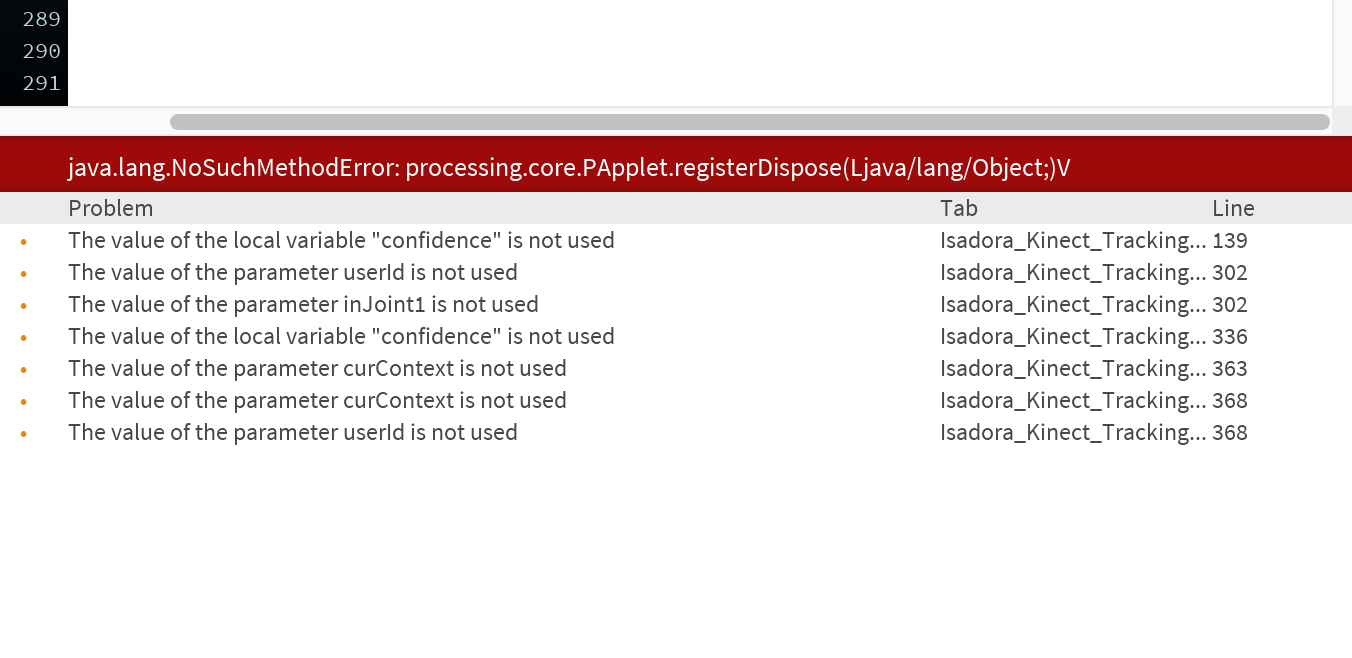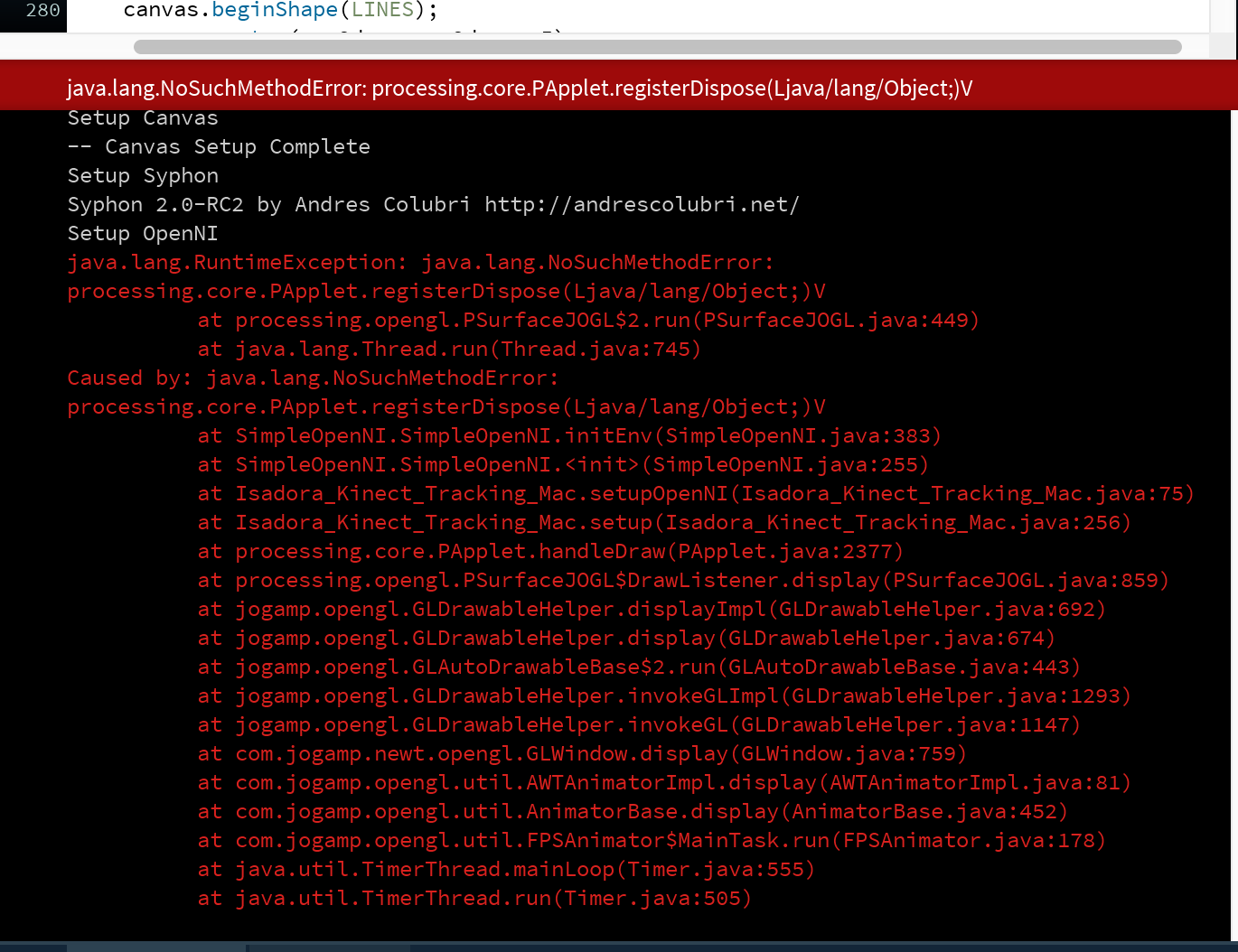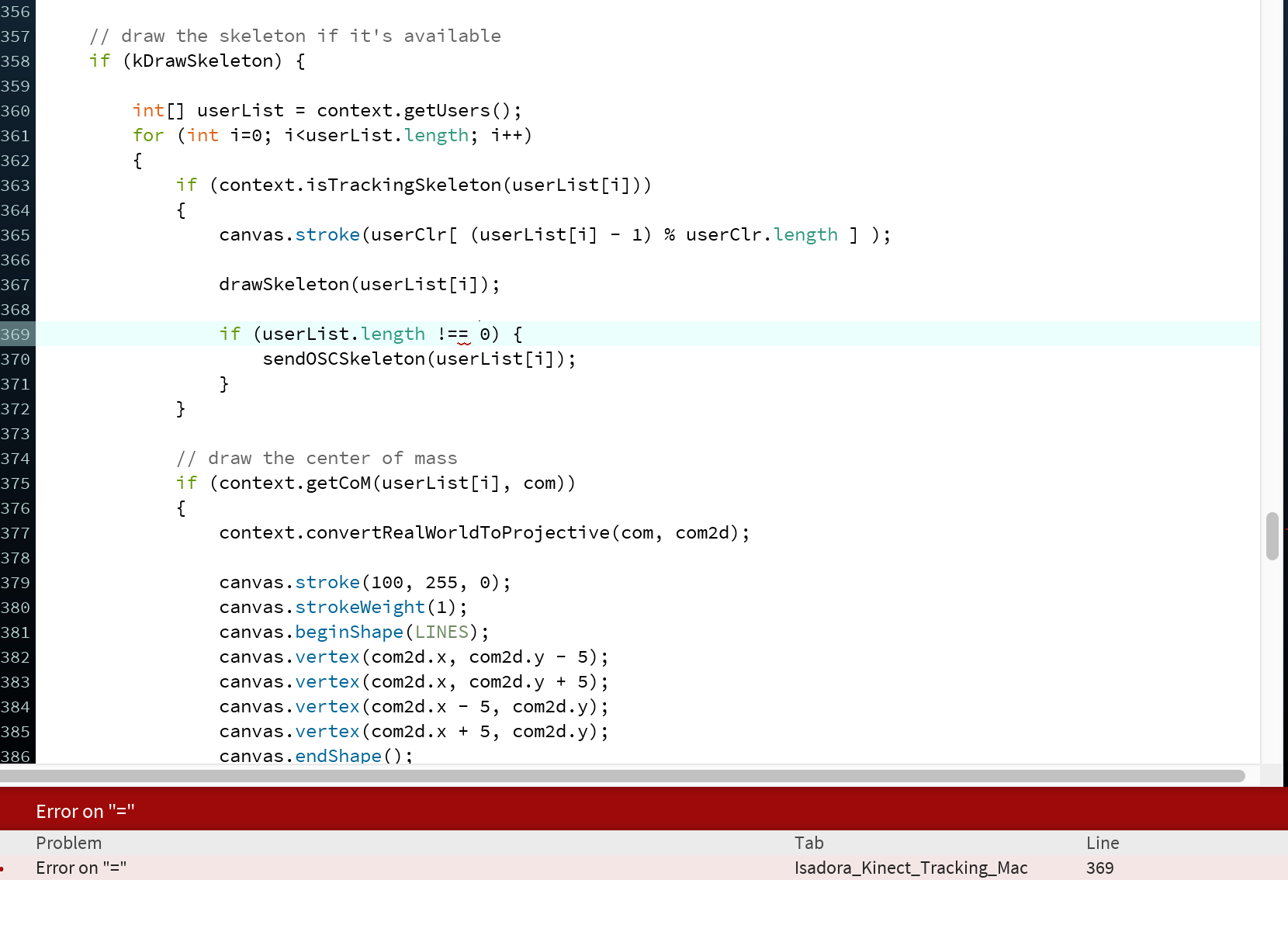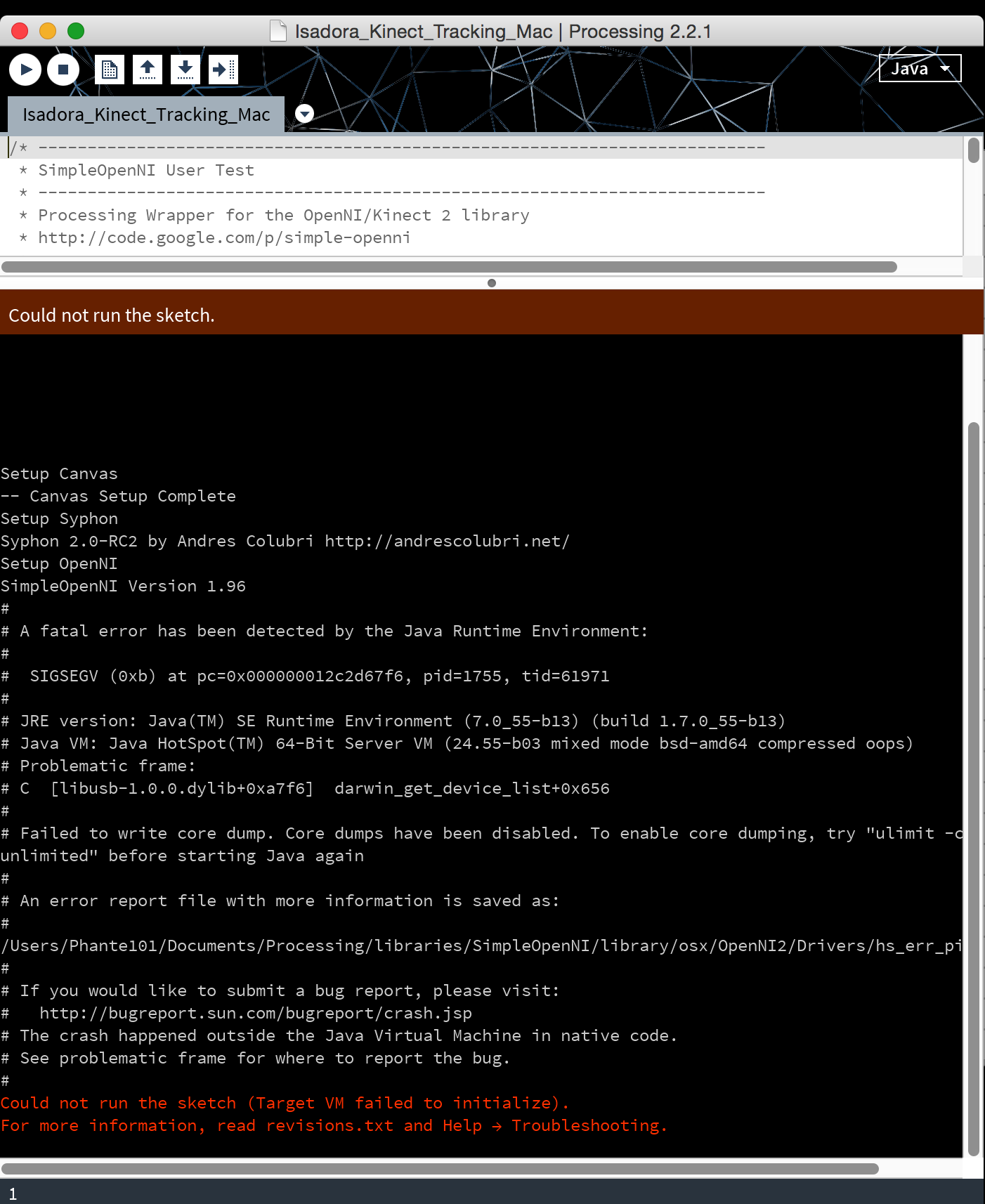Kinect + Isadora Tutorials Now Available
-
On ghost without skeleton there should be no IR image, just the ghost...? Do you mean the ghost keeps vanishing and re-aooearing? This will be down to OpenNI not being able to detect a user... ghost / skeleton needs as much of the entire person from feet to head in the shot as possible as OpenNI works out that a person is stood there by recognising an entire stick figure. It can’t do a tight shot where the user is only there from the waist upwards for instance... or if 50% of the person’s stick figure moves out of shot to the side.
Easier way to diagnose: video your screen on your mobile phone or summat whilst it’s happening and bash it on youtube and post me the link so I can see what’s going on...Could also be USB bandwidth which would cause OpenNI to drop and have to timeout & reinitialise the sensor... which sometimes it can’t do without a complete shutdown of processing / reopening the sketch. I’d only expect this to be an issue if you were using USB external disks or cameras hooked up by USB that’d start saturating your total available USB bus bandwidth.And yes, alpha mask and izzy to blur...At some point I’ll add a blur option into the processing sketch, but can’t give any indication as to when that may be - at the moment the bill-paying work’s having to take priority! -
Ah sorry, my bad on naming issue - yes I can get ghost without skeleton, thanks to shortcut keys.
I think you are right as to why its not been getting the full me in shot. I still have to work with distancing but this week am working from home, so just need to step back more.Thanks for the offer on the youtube clip review, at the moment I am struggling to get it working again where it was last night. I saved the processing file of your Ghost code, which was working with the keys etc too, but is now just beach balling and not picking me up. Hmmm will have to re-assess...I will get back on this when I have figured out what that could be.Could you possibly point me to that mask tutorial you mentioned? Is it the 'how do you get a mask content to follow the mask' one?Do prioritise what you need to keep the roof over your head warm. But all this help is much appreciated, I am no coder, so have to pick up on what language I do understand, it is like being an english tourist abroad, only I am scottish!ThanksG -
Was just looking for it and can't find now. Will try n throw an example Izzy file up later this evening.
NB: if it cuts out and fails to start, and you end up stuck with a beachball, generally it means unplug / replugin your kinect... a resource hasn’t been correctly freed. Or, you’ve forgot to plug in the kinect PSU. -
If all you're wanting is a ghost mask there are other ways that don't involve OpenNI / user / skeleton at all, so can accept waist up etc... and reduces USB bandwidth & CPU load. Will see what I've got in my toolbox and start a new thread for it once I've found it.
-
-
Wow! Thanks so much. Am checking the other thread too. Ideally wanted to use 3 or 4 instances of the ghost, and one of skeleton, as I had wanted to do something where it started in the axis centre (solar plexus) in the chest and spread from there. But will see where I get to with this first as anything approximating would be great, and I may be able to opt for bigger centralised blur etc instead for now.
I would be more than happy with one scene with 2-3 adjust keys, so it can all be fired up in one sitting.Great to have the mask IZZY set up pic too.If I was to use separate scenes, for separate FX using the ghost or skeleton, does the signal take a while to load, and does it interfere with the process if I am not always in view of the Kinect IR sensor?As in is it better to have one complicated scene where the signal is established even if I move in and out of shot, rather than jump between scenes each of which has the set up active as needs to be, user actors etc.Ideally I would have more complicated scenes, which a keyboard watcher can trigger between. At the moment, having achieved skeleton, and being blown away by the possibilities of all the information received and relayed, my head nearly popped, but for this version with so little time, a ghost IR will be more than great.One issue I have is my costume - in one scene its a straightjacket, and its lighting up the IR sensor (like its alive - why I don't know!!!), but obviously my arms aren't available to provide skeleton info feed. So again I think I will have to use the ghost only feed. I'm guessing your Kinect Ghost Mask is going to save my proverbial. Thank you once again @Marci -
Anything reflective... Buckles etc ...will reflect and scatter the infrared pattern that the Kinect projects and then detects. Use talc to dull off reflective fabrics, Vaseline to dull off metals. My glasses always cause problems like this... have to wear contact lenses if I'm working with Kinect.
-
Aah, smart thanks for the tip. It may work in my favour if I can get it to read blob and use IR when I am not in it. Thanks Dude.
-
Hi!
Thank you for great work you do!Following the tutorial I ran into a problem running Processing file on MacError says:"The method enableUser(int) in the type SimpleOpenNI is not applicable for the arguments()"What is the problem here?Igor -
Having trouble linking my kinect to my mac. After I hit run in processes this is what happens.
I'm very new to this. If anyone can help I would really appreciate it.


-
Dear @Bunker,
Are you using Processing v2.2? As noted in the tutorial, SimpleOpenNI only works with v2.2\. It does not work with version 3.As for the error in the third picture, the it should be "!=" instead of "!=="Best Wishes,Mark -
Last error (third picture) is now fixed in the repo (must’ve been doing a lot of JS work that day!)... however, it’ll still error in Processing3 regardless as per @Mark above.
-
Dear @Marci,
As it says in Step 2 of the second tutorial you cannot use Processing v3, you must use Processing v2.2.1\. To wit: **IMPORTANT!** You must install Processing v2.2.1 because SimpleOpenNI has not been updated to support the latest version of Processing!So please try v2.2.1 and let us know how it goes.Best Wishes,Mark -
After doing the changes.. it worked, my mac recognizes now the kinect device. Thank you!!
Is not in this area of the forum but as it seems I'm enjoying this program. is there a site or a place where I can get more tutorials besides the basic 13 episode form youtube??
Once again thank you for your help and such prompt response.
-
@Mark ...??? That's what I reinforced in the post above your response... confused
-
-
-
Would someone mind giving me some guidance? I've followed the instructions in the tutorial to the letter and am still getting nothing showing up in my canvas when I run the setup and an error message I don't even begin to understand in Processing. I'm using the 1414 model Kinect with a MBP Retina 15, bought last year. I understand that the usb3 port may be an issue, is there a work around? Am I screwed?

-
Dear @George_A,
From what I can see, there is a crash in the Java runtime environment when attempting to get a list of USB Devices. The crash is happening in libusb, which is the open source USB input/output library, in a call named darwin_get_device_list.What version of Mac OS are you using?I am unsure how to guide you on this. Many users are using these tools successfully. The only thing I could suggest is to somehow update libusb. The way to do that would be to install Homebrew (see [here](http://brew.sh)) and then enter the command line in Apple's "Terminal" program:brew install libusbI guess that's the only thing I can suggest here as a possible solution.Best Wishes,Mark -
Wandering off on a tangent... a tip for Kinect concept development work based on some playing around this weekend: Get some Lego, some of these: https://www.ebay.co.uk/ulk/itm/121953917174, and apply some judicious use of gaffa tape and scalextric cars & track...
 Start small scale in your studio / kitchen, then scale up. Much easier than leaping about in front of camera / directing small child or significant other... and you can map the whole 'stage' with a single Kinect and projector. Allows for small scale testing of scenarios.
Start small scale in your studio / kitchen, then scale up. Much easier than leaping about in front of camera / directing small child or significant other... and you can map the whole 'stage' with a single Kinect and projector. Allows for small scale testing of scenarios. 